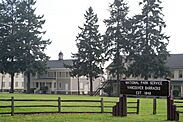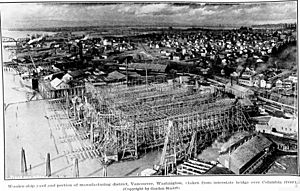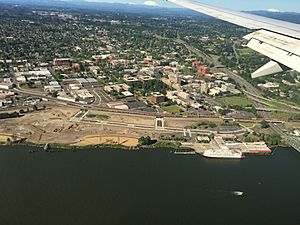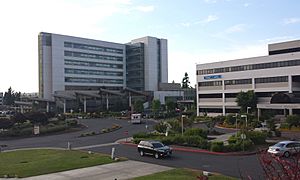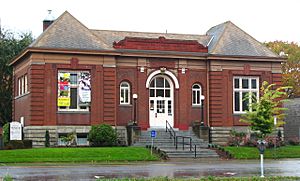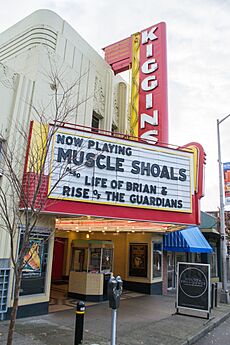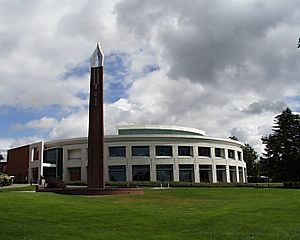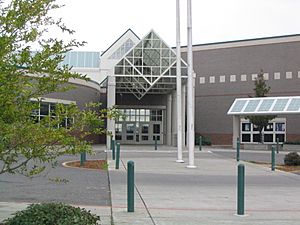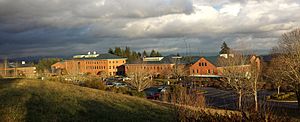Vancouver, Washington facts for kids
Quick facts for kids
Vancouver
|
|||
|---|---|---|---|
|
Skyline of Vancouver with Mount St. Helens in the background
House of Providence
|
|||
|
|||
| Motto(s):
A colorful past, a bright future
|
|||

Location in Washington
|
|||
| Country | United States | ||
| State | Washington | ||
| County | Clark | ||
| Founded | 1825 | ||
| Incorporated | January 23, 1857 | ||
| Named for | George Vancouver | ||
| Government | |||
| • Type | Council–manager | ||
| • Body | Vancouver City Council | ||
| Area | |||
| • City | 52.45 sq mi (135.84 km2) | ||
| • Land | 48.74 sq mi (126.25 km2) | ||
| • Water | 3.70 sq mi (9.59 km2) | ||
| Elevation | 180 ft (50 m) | ||
| Population
(2020)
|
|||
| • City | 190,915 | ||
| • Estimate
(2023)
|
196,442 | ||
| • Rank | U.S.: 132nd WA: 4th |
||
| • Density | 3,784.32/sq mi (1,461.14/km2) | ||
| • Urban | 2,104,238 (US: 23rd) | ||
| • Metro | 2,509,489 (US: 25th) | ||
| Demonym(s) | Vancouverite | ||
| Time zone | UTC−8 (Pacific (PST)) | ||
| • Summer (DST) | UTC−7 (PDT) | ||
| ZIP Codes |
98660–98666, 98668, 98682–98687
|
||
| Area code(s) | 360, 564 | ||
| FIPS code | 53-74060 | ||
| GNIS feature ID | 2412146 | ||
Vancouver is a city in the U.S. state of Washington. It sits on the north bank of the Columbia River in Clark County. The city was founded in 1825 and became an official city in 1857. In 2020, Vancouver had about 190,915 people, making it the fourth-largest city in Washington. It is the main city of Clark County and part of the larger Portland-Vancouver metropolitan area. Vancouver is located right on the border between Washington and Oregon, just north of Portland.
Contents
Why is it Called Vancouver?
Vancouver, Washington, shares its name with the bigger city of Vancouver in Canada. Both cities are named after a British sea captain, George Vancouver. The U.S. city is actually older. Vancouver, Canada, became a city 29 years after Vancouver, Washington. The name "Vancouver" was first used for the Fort Vancouver trading post more than 60 years earlier.
Sometimes, people suggest changing the U.S. city's name to "Fort Vancouver." This would help avoid confusion with the larger Canadian city. People often say "Vancouver, B.C." for the Canadian city and "Vancouver, Washington" or "Vancouver, USA" for the U.S. city. Some local nicknames are "Vantucky" and "The 'Couv(e)".
History of Vancouver
Early Settlements and Explorers
The Vancouver area was first home to Native American tribes like the Chinook and Klickitat. They lived in permanent settlements with longhouses made of timber. The Chinookan name for the area was Skit-so-to-ho, and the Klickitat name was Ala-si-kas. Both names meant "land of the mud-turtles."
The first Europeans arrived in 1792 with William Robert Broughton. Sadly, about half of the native people died from smallpox before the Lewis and Clark Expedition came in 1806. Over the next 50 years, other diseases like measles and influenza greatly reduced the Chinookan population.
How Vancouver Began in the 1800s
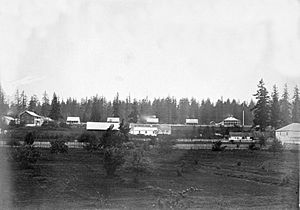
Meriwether Lewis thought the Vancouver area was the best place to settle west of the Rocky Mountains. The first lasting European settlement started in 1824. This was when Hudson's Bay Company built Fort Vancouver as a fur trading post.
For a while, both the U.S. and Britain controlled the area together. This "joint occupation" ended in 1846 with the Oregon Treaty. This treaty gave the United States full control. Vancouver officially became a city on January 23, 1857.
For a short time in 1859–60, Vancouver was the capital of Washington Territory. But the capital was soon moved back to Olympia.
Vancouver in the 1900s
Before 1917, people crossed the Columbia River by ferry to get to Oregon. Then, the new Interstate Bridge opened. Vancouver had three shipyards that built ships for World War I.
During World War II, Vancouver saw a huge economic boom. An Alcoa aluminum plant opened in 1940, using cheap power from the Bonneville Dam. After the attack on Pearl Harbor, Henry Kaiser opened a large shipyard. By 1944, this shipyard employed 36,000 people. They worked non-stop to build ships like Liberty ships. This brought many workers to Vancouver, and the city's population grew from 18,000 to over 80,000 in just a few months. This led to the creation of new neighborhoods.
Vancouver has grown quickly, leading to some changes. In 1997, the city grew much larger, adding 11,258 acres and 58,171 residents. Because of this growth, Vancouver is often seen as two areas: East and West Vancouver. West Vancouver has the downtown area and older parts of the city. East Vancouver includes newer communities like Cascade Park.
Vancouver in the 2000s
Many people who live near Vancouver, just outside the city limits, are part of the Vancouver urban area. If the city had approved a major growth plan in 2006, Vancouver would have become the second-largest city in Washington.
Military History in Vancouver
Vancouver has a strong military history. From 1852 to 1854, future U.S. President Ulysses S. Grant served here as a captain. Other famous generals like George B. McClellan and George C. Marshall also served in Vancouver.
Vancouver Barracks was a very large Army base. It stretched from the river to what is now Fourth Plain Boulevard. Pearson Field was also an important military airport. In 1937, a Russian pilot named Valery Chkalov landed here after a record-breaking flight over the North Pole from Moscow. A monument near Pearson Field remembers this event.
Geography and Climate
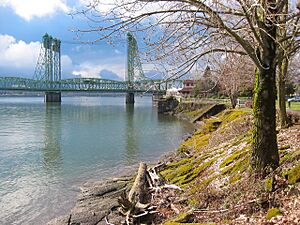
Vancouver is located north of the Columbia River and the Oregon border. It is near where the Columbia River Gorge cuts through the Cascade Range mountains. When the weather is clear, you can see several volcanoes from Vancouver, including Mount Hood, Mount St. Helens, and Mount Rainier.
The city covers about 49.86 square miles. Most of this is land, with about 3.4 square miles of water.
What is Vancouver's Weather Like?
Vancouver has a climate similar to Portland, Oregon. It has warm summers and wet winters. Sometimes, cold winds blow down the Columbia River Gorge. This can cause "silver thaw" storms, where freezing rain covers trees and power lines. These storms can cause power outages.
It rains often in the fall, winter, and spring. But the rain usually stops by mid-June, and the weather stays dry and warm through September. Vancouver gets about 42 inches of rain each year. Heavy snow is rare, and big snowstorms only happen every 2–4 years.
The city is close to the river, so flooding used to be a concern. Major floods happened in 1894 and 1948. The 1948 flood destroyed nearby Vanport, Oregon. Unusual storms have also hit Vancouver, including a strong windstorm in 1962 and a tornado in 1972. Another tornado struck in 2008, causing some damage.
Many Vancouver residents work in Portland. This means there is often a lot of traffic on the two bridges that cross the Columbia River: the Interstate Bridge and the Glenn Jackson Bridge.
| Climate data for Vancouver, Washington (1991–2020 normals, extremes 1891–present) | |||||||||||||
|---|---|---|---|---|---|---|---|---|---|---|---|---|---|
| Month | Jan | Feb | Mar | Apr | May | Jun | Jul | Aug | Sep | Oct | Nov | Dec | Year |
| Record high °F (°C) | 66 (19) |
73 (23) |
83 (28) |
90 (32) |
99 (37) |
115 (46) |
108 (42) |
105 (41) |
103 (39) |
90 (32) |
72 (22) |
65 (18) |
115 (46) |
| Mean maximum °F (°C) | 57.9 (14.4) |
60.7 (15.9) |
69.6 (20.9) |
78.4 (25.8) |
86.7 (30.4) |
91.0 (32.8) |
96.1 (35.6) |
96.8 (36.0) |
91.1 (32.8) |
77.1 (25.1) |
63.8 (17.7) |
58.3 (14.6) |
99.5 (37.5) |
| Mean daily maximum °F (°C) | 47.0 (8.3) |
51.0 (10.6) |
56.1 (13.4) |
61.2 (16.2) |
68.3 (20.2) |
73.5 (23.1) |
80.9 (27.2) |
81.6 (27.6) |
75.8 (24.3) |
63.7 (17.6) |
53.0 (11.7) |
46.5 (8.1) |
63.2 (17.3) |
| Daily mean °F (°C) | 40.7 (4.8) |
43.1 (6.2) |
47.2 (8.4) |
51.7 (10.9) |
58.3 (14.6) |
63.3 (17.4) |
69.0 (20.6) |
69.4 (20.8) |
63.9 (17.7) |
54.2 (12.3) |
46.2 (7.9) |
40.8 (4.9) |
54.0 (12.2) |
| Mean daily minimum °F (°C) | 34.4 (1.3) |
35.1 (1.7) |
38.4 (3.6) |
42.2 (5.7) |
48.2 (9.0) |
53.0 (11.7) |
57.1 (13.9) |
57.2 (14.0) |
52.0 (11.1) |
44.8 (7.1) |
39.4 (4.1) |
35.0 (1.7) |
44.7 (7.1) |
| Mean minimum °F (°C) | 22.0 (−5.6) |
22.5 (−5.3) |
27.3 (−2.6) |
31.8 (−0.1) |
36.8 (2.7) |
43.9 (6.6) |
48.3 (9.1) |
48.0 (8.9) |
41.7 (5.4) |
32.3 (0.2) |
25.9 (−3.4) |
21.4 (−5.9) |
16.8 (−8.4) |
| Record low °F (°C) | −8 (−22) |
−3 (−19) |
18 (−8) |
24 (−4) |
28 (−2) |
34 (1) |
37 (3) |
35 (2) |
28 (−2) |
21 (−6) |
6 (−14) |
−10 (−23) |
−10 (−23) |
| Average precipitation inches (mm) | 5.34 (136) |
3.77 (96) |
3.95 (100) |
2.93 (74) |
2.51 (64) |
1.61 (41) |
0.42 (11) |
0.52 (13) |
1.43 (36) |
3.41 (87) |
5.51 (140) |
6.07 (154) |
37.47 (952) |
| Average snowfall inches (cm) | 0.8 (2.0) |
1.1 (2.8) |
0.4 (1.0) |
0.0 (0.0) |
0.0 (0.0) |
0.0 (0.0) |
0.0 (0.0) |
0.0 (0.0) |
0.0 (0.0) |
0.0 (0.0) |
0.0 (0.0) |
0.5 (1.3) |
2.8 (7.1) |
| Average precipitation days (≥ 0.01 in.) | 19.9 | 15.8 | 18.0 | 17.4 | 12.6 | 9.1 | 3.7 | 3.5 | 7.1 | 14.7 | 19.1 | 20.3 | 161.2 |
| Average snowy days (≥ 0.1 in.) | 0.3 | 0.8 | 0.2 | 0.0 | 0.0 | 0.0 | 0.0 | 0.0 | 0.0 | 0.0 | 0.0 | 0.5 | 1.4 |
| Source: NOAA (snowfall and snowy days 1981-2010) | |||||||||||||
People of Vancouver
| Historical population | |||
|---|---|---|---|
| Census | Pop. | %± | |
| 1880 | 1,722 | — | |
| 1890 | 3,545 | 105.9% | |
| 1900 | 3,126 | −11.8% | |
| 1910 | 9,300 | 197.5% | |
| 1920 | 12,637 | 35.9% | |
| 1930 | 15,766 | 24.8% | |
| 1940 | 18,788 | 19.2% | |
| 1950 | 41,664 | 121.8% | |
| 1960 | 32,464 | −22.1% | |
| 1970 | 41,859 | 28.9% | |
| 1980 | 42,834 | 2.3% | |
| 1990 | 46,380 | 8.3% | |
| 2000 | 143,560 | 209.5% | |
| 2010 | 161,791 | 12.7% | |
| 2020 | 190,915 | 18.0% | |
| 2023 (est.) | 196,442 | 21.4% | |
| U.S. Decennial Census 2020 Census |
|||
What is Vancouver's Population Like?
In 2020, Vancouver had 190,915 people living in 75,663 households. The city had about 3,917 people per square mile.
Most people in Vancouver (76.5%) are White. Other groups include African American (2.3%), Asian (5.5%), and Native American (0.6%). About 14.7% of the population is Hispanic or Latino.
The average household had 2.46 people. About 22.1% of the people were under 18 years old. About 15.7% were older than 65. The population was almost evenly split between females (50.6%) and males (49.4%).
The average household income was $67,462. About 12.7% of the population lived below the poverty line.
Many people in Vancouver have German (16.1%), English (10.9%), or Irish (9.7%) backgrounds.
Economy and Jobs
Vancouver's economy is affected by its location next to Portland, Oregon. Washington state does not have income taxes, but it has a sales tax. Oregon has no sales tax, but it has a high state income tax. Because of this, many Vancouver residents might shop in Portland to avoid sales tax. They might live and work in Vancouver to avoid state income tax. This makes Vancouver a popular place for people who are retired.
Historically, Vancouver's economy started with fishing and trade by the Chinook people. Then, the Hudson's Bay Company focused on fur trading and timber. Farming also grew, with crops like apples and strawberries.
In the early 1900s, the city's economy focused on lumber and activities around Vancouver Barracks. The Interstate Bridge and Bonneville Dam led to a big industrial boom in the 1940s. This included the Kaiser shipyard and Alcoa aluminum plant.
As old forests were used up and heavy industries moved away, Vancouver's economy changed. Now, it focuses more on high-tech and service jobs. Many residents travel to Portland for work. Companies like Nautilus, Inc., ZoomInfo, Papa Murphy's Pizza, and The Holland (which owns Burgerville) have their main offices in Vancouver.
The Port of Vancouver USA is busy, handling over 400 large ships each year. It also handles many barges that travel the Columbia River.
Top Employers in Vancouver
Here are some of the largest employers in Vancouver:
- PeaceHealth (16,500 employees)
- Vancouver Public Schools (2,957 employees)
- Evergreen Public Schools (2,203 employees)
- Vancouver Clinic (1,452 employees)
- Battle Ground Public Schools (1,380 employees)
- SEH America Inc. (867 employees)
- Dick Hannah Dealerships (659 employees)
- Columbia Machine Inc. (535 employees)
- Tapani Inc. (500 employees)
- Clark County Public Transportation Benefit (431 employees)
Making Downtown Vancouver Better
Since 1997, Vancouver has been working to improve its downtown area. New tall buildings, like condominiums, have been built around Esther Short Park. A Hilton hotel was also built near the park.
Downtown Vancouver continued to grow even after a slow period around 2009–2012. By mid-2020, many new buildings were finished or being built.
In 2016, work began on a big project to redevelop Vancouver's waterfront. This area used to be a paper mill and was closed to the public for over 100 years. The project plans for 3,300 homes and a million square feet of offices and shops. In 2018, the waterfront officially opened to the public. It includes the Grant Street Pier, a viewing deck over the Columbia River.
The city council also approved a plan to redevelop Terminal One in 2017. This project will include a new Marriott hotel and other buildings. There are also plans for a public open-air market.
The Columbian newspaper moved to a new building in 2008. In 2010, the City of Vancouver bought this building to use as its new city hall. This move helped the city save money.
The Fort Vancouver Regional Library District opened a new library in 2011.
Arts and Culture
In the early 2000s, Vancouver's arts and culture scene started to grow. Many art galleries are in downtown Vancouver. In 2014, the city officially named the downtown area an "Arts District."
The Kiggins Theatre in downtown Vancouver was built in 1936. It was named after J.P. Kiggins, a local politician and businessman. The theater was updated and reopened in 2011. It now shows independent films and hosts community events.
The Vancouver Symphony Orchestra started in the late 1970s. It performs concerts regularly.
Fun Annual Events
- The Recycled Arts Festival happens every June in Esther Short Park. It shows art made from at least 75% reused or recycled materials. It also has live music and food.
- Since the 1960s, Vancouver has hosted a Fourth of July fireworks display at Fort Vancouver National Historic Site. This event brings many people to the city. It used to be one of the largest fireworks shows west of the Mississippi River.
- The 4 Days of Aloha, or Hawaiian Festival, takes place in late July. It celebrates Hawaiian food, arts, and culture with live music and dance.
- In late August, the Vancouver Wine and Jazz Festival is held in Esther Short Park. It is one of the biggest jazz festivals in the Pacific Northwest.
Interesting Buildings and Architecture
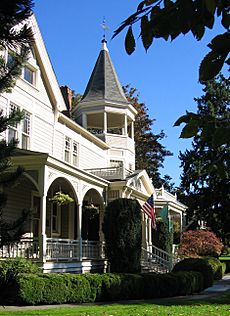
Vancouver has many different types of buildings because of its long history. You can find Victorian homes and craftsman bungalows downtown. There are also smaller wartime homes and ranch-style houses in other parts of the city.
The reconstructed Fort Vancouver is part of the Fort Vancouver National Historic Site. The city was named one of the "Dozen Distinctive Destinations" in 2003 for its history.
Other notable buildings include:
- The Covington House (1846–1848), a log cabin.
- Officers Row, with historic homes like the Grant House and the Marshall House.
- Mother Joseph's Providence Academy, built in 1873.
- The Proto-Cathedral of St. James the Greater, where the first Roman Catholic Mass was held in 1885.
- The Carnegie library (1909), now the Clark County Historical Museum.
- The 1914 U.S. National Bank (now the Heritage Building).
- The 1916 U.S. Post Office.
- The vertical-lift Interstate Bridge, which opened in 1917.
- The 1935 art deco telephone exchange building.
- The 1941 Clark County Courthouse.
- Smith Tower, a round apartment building built in 1965.
- The Hilton Hotel and Vancouver Convention Center.
Many of these old buildings have been given new uses. For example, the Slocum House, an old villa, now holds a winery and art gallery. The Carnegie Library became the Clark County Historical Museum.
Education in Vancouver
Public Schools
Vancouver has two main school districts: Vancouver Public Schools and Evergreen School District.
Vancouver Public Schools covers most of west Vancouver. It has seven high schools, six middle schools, and many elementary schools. Some high schools are Hudson's Bay High School and Skyview High School.
The Evergreen School District covers most of east Vancouver. It has seven high schools, including Evergreen High School and Mountain View High School. It also has six middle schools and 21 elementary schools.
Vancouver is also home to the Washington School for the Deaf and Washington School for the Blind.
Colleges and Universities
- Clark College (a two-year college)
- Gateway Seminary
- Washington State University, Vancouver
Media
Vancouver is part of the Portland, Oregon, media market for news, radio, and TV. However, it has its own local newspaper, The Columbian.
Transportation
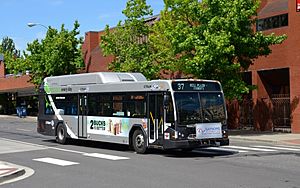
Vancouver has two major interstate highways, I-5 and I-205. Both run north and south, crossing the Columbia River into Portland and continuing toward Seattle. There are also two busy state highways within the city: SR 14 and SR 500.
The local public transportation system is C-Tran. It operates buses, vanpools, and special transit vehicles. C-Tran also has express routes that go into downtown Portland.
There have been talks about extending Portland's Max Light Rail system into Vancouver. Voters have rejected this idea in the past. However, a new plan in 2022 for the Interstate Bridge Replacement Program includes a proposal for a light rail extension into downtown Vancouver.
Vancouver has good rail service. Freight trains from BNSF and Union Pacific operate here. Amtrak, the national passenger rail system, serves Vancouver Station. You can take long-distance trains like the Coast Starlight and Empire Builder, or the regional Amtrak Cascades.
Pearson Field, near downtown Vancouver, is the main airport for the city. It is mostly used for private planes. The closest airport for commercial flights is Portland International Airport (PDX).
Famous People from Vancouver
Sister City
Vancouver has one sister city:
See also
 In Spanish: Vancouver (Washington) para niños
In Spanish: Vancouver (Washington) para niños



